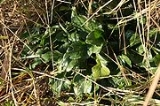
Sea beet
Encyclopedia
The sea beet, Beta vulgaris subsp. maritima ((L.) Arcangeli.), is a member of the family Chenopodiaceae
. Carl Linnaeus first described Beta vulgaris in 1753; in the second edition of Species Plantarum
in 1762 he divided the species into wild and cultivated varieties, giving the name Beta maritima to the wide taxon.
The sea beet is native to the coasts of Europe
, northern Africa
, and southern Asia
. It also lives in the wild along some shores in Great Britain
.
The sea beet is the wild ancestor of common vegetables such as beetroot
, sugar beet
, and Swiss chard
. Its leaves have a pleasant texture and taste when served raw or cooked, and because of this it is also known as wild spinach.
It is a perennial plant
which grows up to 1.2 m, and flowers in the summer. Its flowers are hermaphroditic, and wind-pollinated. It requires moist, well-drained soils, and does not tolerate shade. However, it is able to tolerate relatively high levels of sodium in its environment because its leaves are waxy and can endure the salty breeze.
Chenopodiaceae
Chenopodiaceae were a family of flowering plants, also called the Goosefoot Family. They are now included within family Amaranthaceae. The vast majority of Chenopods are weeds, and many are salt and drought tolerant. A few food crops also belong to the family: spinach, beets, chard, quinoa, and...
. Carl Linnaeus first described Beta vulgaris in 1753; in the second edition of Species Plantarum
Species Plantarum
Species Plantarum was first published in 1753, as a two-volume work by Carl Linnaeus. Its prime importance is perhaps that it is the primary starting point of plant nomenclature as it exists today. This means that the first names to be considered validly published in botany are those that appear...
in 1762 he divided the species into wild and cultivated varieties, giving the name Beta maritima to the wide taxon.
The sea beet is native to the coasts of Europe
Europe
Europe is, by convention, one of the world's seven continents. Comprising the westernmost peninsula of Eurasia, Europe is generally 'divided' from Asia to its east by the watershed divides of the Ural and Caucasus Mountains, the Ural River, the Caspian and Black Seas, and the waterways connecting...
, northern Africa
Africa
Africa is the world's second largest and second most populous continent, after Asia. At about 30.2 million km² including adjacent islands, it covers 6% of the Earth's total surface area and 20.4% of the total land area...
, and southern Asia
Asia
Asia is the world's largest and most populous continent, located primarily in the eastern and northern hemispheres. It covers 8.7% of the Earth's total surface area and with approximately 3.879 billion people, it hosts 60% of the world's current human population...
. It also lives in the wild along some shores in Great Britain
Great Britain
Great Britain or Britain is an island situated to the northwest of Continental Europe. It is the ninth largest island in the world, and the largest European island, as well as the largest of the British Isles...
.
The sea beet is the wild ancestor of common vegetables such as beetroot
Beetroot
The beetroot, also known as the table beet, garden beet, red beet or informally simply as beet, is one of the many cultivated varieties of beets and arguably the most commonly encountered variety in North America, Central America and Britain.-Consumption:The usually deep-red roots of beetroot are...
, sugar beet
Sugar beet
Sugar beet, a cultivated plant of Beta vulgaris, is a plant whose tuber contains a high concentration of sucrose. It is grown commercially for sugar production. Sugar beets and other B...
, and Swiss chard
Chard
Chard , is a leafy green vegetable often used in Mediterranean cooking. While the leaves are always green, chard stalks vary in color. Chard has been bred to have highly nutrious leaves at the expense of the root...
. Its leaves have a pleasant texture and taste when served raw or cooked, and because of this it is also known as wild spinach.
It is a perennial plant
Perennial plant
A perennial plant or simply perennial is a plant that lives for more than two years. The term is often used to differentiate a plant from shorter lived annuals and biennials. The term is sometimes misused by commercial gardeners or horticulturalists to describe only herbaceous perennials...
which grows up to 1.2 m, and flowers in the summer. Its flowers are hermaphroditic, and wind-pollinated. It requires moist, well-drained soils, and does not tolerate shade. However, it is able to tolerate relatively high levels of sodium in its environment because its leaves are waxy and can endure the salty breeze.

